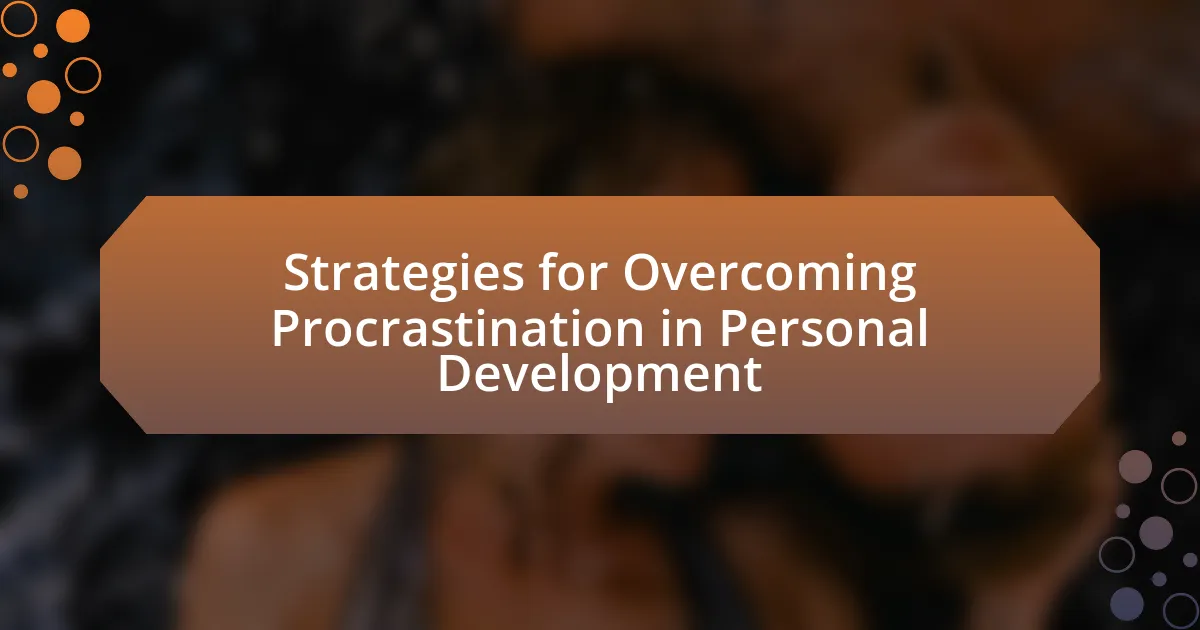The article focuses on strategies for overcoming procrastination in personal development, identifying key causes such as fear of failure, lack of motivation, and poor time management. It explores the psychological factors that contribute to procrastination, including anxiety and perfectionism, as well as environmental influences like distractions and workspace organization. The article also presents effective strategies to combat procrastination, such as setting SMART goals, breaking tasks into smaller steps, and employing time management techniques like the Pomodoro Technique. Additionally, it emphasizes the importance of accountability and maintaining motivation through structured routines and positive reinforcement.

What are the main causes of procrastination in personal development?
The main causes of procrastination in personal development include fear of failure, lack of motivation, and poor time management. Fear of failure often leads individuals to avoid tasks that they perceive as challenging, resulting in delays in personal growth. Lack of motivation can stem from unclear goals or a disconnect between personal values and the tasks at hand, causing individuals to prioritize short-term comfort over long-term development. Poor time management skills contribute to procrastination by making it difficult for individuals to allocate sufficient time for personal development activities, leading to a cycle of avoidance and inaction.
How do psychological factors contribute to procrastination?
Psychological factors significantly contribute to procrastination by influencing an individual’s motivation, self-regulation, and emotional responses. For instance, fear of failure can lead to avoidance behaviors, where individuals delay tasks to escape potential negative outcomes. Research by Steel (2007) in “The Nature of Procrastination: A Meta-Analytic and Theoretical Review of Quantitative Research” indicates that high levels of anxiety and perfectionism correlate with increased procrastination, as individuals may feel overwhelmed by their own expectations. Additionally, low self-efficacy can diminish motivation, causing individuals to doubt their ability to complete tasks effectively, further perpetuating procrastination.
What role does fear of failure play in procrastination?
Fear of failure significantly contributes to procrastination by creating anxiety that leads individuals to avoid tasks. This avoidance stems from the belief that failing to complete a task successfully will result in negative consequences, such as judgment or loss of self-esteem. Research indicates that individuals with high levels of fear of failure are more likely to procrastinate, as they prioritize short-term relief from anxiety over long-term goals. A study published in the Journal of Personality and Social Psychology by Conroy, Willow, and Metzler (2002) found that fear of failure is a strong predictor of procrastination behaviors, highlighting the psychological link between the two.
How does perfectionism affect procrastination behaviors?
Perfectionism significantly contributes to procrastination behaviors by creating unrealistic standards that individuals feel compelled to meet. When perfectionists set excessively high goals, they often experience anxiety and fear of failure, which leads to avoidance of tasks altogether. Research indicates that individuals with high levels of perfectionism are more likely to delay starting or completing tasks due to the pressure of achieving perfection, as evidenced by a study published in the journal “Personality and Individual Differences,” which found a strong correlation between perfectionism and procrastination tendencies. This relationship highlights how the pursuit of flawlessness can hinder productivity and lead to chronic procrastination.
What environmental factors influence procrastination?
Environmental factors that influence procrastination include distractions, workspace organization, and social influences. Distractions such as noise, clutter, and digital interruptions can significantly hinder focus and productivity, leading to procrastination. A disorganized workspace can create a sense of overwhelm, making it difficult for individuals to start tasks. Additionally, social influences, including peer pressure and the presence of procrastinating individuals, can reinforce procrastination behaviors. Research indicates that environments that promote focus and minimize distractions can reduce procrastination rates, highlighting the importance of a conducive setting for task completion.
How does a cluttered workspace impact productivity?
A cluttered workspace negatively impacts productivity by creating distractions and increasing stress levels. Research indicates that individuals working in disorganized environments experience difficulty focusing, which can lead to decreased efficiency and effectiveness in task completion. A study published in the Journal of Environmental Psychology found that clutter can overwhelm cognitive processes, making it harder for individuals to concentrate and prioritize tasks. This disorganization can result in wasted time searching for items and a general sense of chaos, further hindering productivity.
What is the effect of social distractions on personal development?
Social distractions negatively impact personal development by diverting attention and reducing focus on self-improvement activities. Research indicates that frequent interruptions from social media and other social interactions can lead to decreased productivity and hinder goal achievement. A study published in the Journal of Applied Psychology found that individuals who frequently engage in social distractions experience lower levels of task completion and diminished cognitive performance, which directly affects their ability to develop skills and achieve personal growth.

What strategies can be employed to overcome procrastination?
To overcome procrastination, individuals can employ strategies such as setting specific goals, breaking tasks into smaller steps, and utilizing time management techniques. Setting specific goals provides clarity and direction, making it easier to focus on what needs to be accomplished. Breaking tasks into smaller, manageable steps reduces feelings of overwhelm, allowing individuals to make progress incrementally. Time management techniques, such as the Pomodoro Technique, which involves working in focused intervals followed by short breaks, can enhance productivity and maintain motivation. Research indicates that these strategies can significantly reduce procrastination, as evidenced by a study published in the Journal of Behavioral Medicine, which found that structured goal-setting and time management improved task completion rates among participants.
How can time management techniques help reduce procrastination?
Time management techniques can significantly reduce procrastination by providing structured approaches to prioritize tasks and allocate time effectively. Techniques such as the Pomodoro Technique, which involves working in focused intervals followed by short breaks, enhance concentration and make daunting tasks feel more manageable. Research indicates that individuals who implement time management strategies report a 25% increase in productivity and a decrease in procrastination behaviors, as they create clear deadlines and accountability. Additionally, setting specific goals and breaking tasks into smaller, actionable steps can help individuals overcome the overwhelm that often leads to procrastination, thereby fostering a more proactive mindset.
What are the most effective time-blocking methods?
The most effective time-blocking methods include the Pomodoro Technique, the Time Blocking Method, and the Eisenhower Matrix. The Pomodoro Technique involves working in focused intervals of 25 minutes followed by a 5-minute break, which enhances concentration and reduces burnout. The Time Blocking Method allocates specific blocks of time for different tasks throughout the day, promoting structure and prioritization. The Eisenhower Matrix categorizes tasks based on urgency and importance, helping individuals focus on what truly matters. Research indicates that structured time management techniques like these can significantly reduce procrastination and improve productivity, as evidenced by studies showing that individuals who implement time-blocking report higher task completion rates and lower stress levels.
How does the Pomodoro Technique aid in maintaining focus?
The Pomodoro Technique aids in maintaining focus by breaking work into short, timed intervals called “Pomodoros,” typically lasting 25 minutes, followed by a short break. This structured approach helps individuals concentrate on a single task without distractions, as the time constraint encourages urgency and minimizes the temptation to multitask. Research indicates that this method can enhance productivity and focus by creating a sense of urgency and allowing for regular mental breaks, which prevent burnout and maintain cognitive performance. Studies have shown that time management techniques like the Pomodoro Technique can lead to improved task completion rates and better focus among users.
What role does goal setting play in overcoming procrastination?
Goal setting plays a crucial role in overcoming procrastination by providing clear objectives and a structured framework for action. When individuals set specific, measurable, achievable, relevant, and time-bound (SMART) goals, they create a roadmap that enhances focus and motivation. Research indicates that goal setting increases commitment and accountability, which are essential for reducing procrastination. For instance, a study published in the Journal of Applied Psychology found that individuals who set specific goals were more likely to complete tasks on time compared to those who did not set goals. This demonstrates that effective goal setting not only clarifies priorities but also fosters a sense of urgency, thereby mitigating the tendency to procrastinate.
How can SMART goals be utilized to enhance motivation?
SMART goals can enhance motivation by providing a clear framework that makes objectives Specific, Measurable, Achievable, Relevant, and Time-bound. This structured approach helps individuals break down larger tasks into manageable steps, which can reduce feelings of overwhelm and increase focus. Research indicates that setting specific and challenging goals leads to higher performance compared to vague or easy goals, as demonstrated in a study by Locke and Latham (2002) published in the “American Psychologist.” By establishing clear milestones, individuals can track their progress, celebrate small wins, and maintain motivation throughout the process, ultimately reducing procrastination and fostering a sense of accomplishment.
What are the benefits of breaking tasks into smaller steps?
Breaking tasks into smaller steps enhances productivity and reduces procrastination. This approach allows individuals to manage their workload more effectively by creating clear, achievable goals, which can lead to increased motivation and a sense of accomplishment. Research indicates that breaking tasks into smaller components can improve focus and reduce feelings of overwhelm, as evidenced by a study published in the Journal of Experimental Psychology, which found that participants who divided tasks into smaller segments reported higher completion rates and lower anxiety levels. By simplifying complex tasks, individuals can maintain momentum and make steady progress, ultimately leading to successful outcomes in personal development.

How can individuals maintain motivation to prevent future procrastination?
Individuals can maintain motivation to prevent future procrastination by setting clear, achievable goals and breaking tasks into smaller, manageable steps. This approach allows individuals to experience a sense of accomplishment as they complete each step, reinforcing their motivation. Research indicates that goal-setting enhances performance and motivation; for instance, a study published in the American Journal of Lifestyle Medicine found that specific and challenging goals lead to higher performance levels compared to vague or easy goals. Additionally, establishing a routine and incorporating regular rewards for completing tasks can further sustain motivation, as positive reinforcement encourages continued effort and focus.
What are effective self-motivation techniques?
Effective self-motivation techniques include setting specific goals, breaking tasks into smaller steps, and using positive reinforcement. Setting specific goals provides clarity and direction, making it easier to stay focused. Research shows that individuals who set clear, achievable goals are more likely to succeed in their endeavors. Breaking tasks into smaller steps reduces overwhelm and allows for incremental progress, which can enhance motivation. Positive reinforcement, such as rewarding oneself after completing a task, has been proven to increase motivation and reinforce desired behaviors. These techniques are supported by psychological studies that highlight the importance of goal-setting and reward systems in enhancing self-motivation.
How does positive self-talk influence motivation levels?
Positive self-talk significantly enhances motivation levels by fostering a constructive mindset that encourages goal achievement. When individuals engage in positive self-talk, they reinforce their belief in their abilities, which leads to increased confidence and a greater willingness to take action. Research by Seligman et al. (2005) indicates that positive self-talk can improve performance and persistence in challenging tasks, as it helps individuals focus on their strengths rather than their weaknesses. This shift in perspective not only boosts motivation but also reduces anxiety, making it easier to tackle procrastination and pursue personal development goals effectively.
What is the impact of visualizing success on personal development?
Visualizing success significantly enhances personal development by fostering motivation and clarity in goal-setting. When individuals visualize their desired outcomes, they create a mental image that serves as a powerful motivator, encouraging them to take actionable steps toward achieving those goals. Research indicates that visualization activates the same neural pathways as actual performance, which can improve confidence and reduce anxiety related to pursuing goals. A study published in the Journal of Applied Psychology found that individuals who practiced visualization techniques reported higher levels of motivation and were more likely to achieve their objectives compared to those who did not engage in such practices. This demonstrates that visualizing success not only clarifies aspirations but also reinforces the commitment to personal growth and overcoming procrastination.
What habits can be developed to sustain productivity?
To sustain productivity, individuals can develop habits such as setting specific goals, prioritizing tasks, and maintaining a consistent routine. Setting specific goals provides clear direction and measurable outcomes, which enhances focus and motivation. Prioritizing tasks using methods like the Eisenhower Matrix helps individuals distinguish between urgent and important tasks, ensuring that time is allocated effectively. Maintaining a consistent routine fosters discipline and reduces decision fatigue, allowing for smoother transitions between tasks. Research indicates that individuals who establish structured routines are more likely to achieve their goals and maintain higher levels of productivity over time.
How can daily routines be structured to minimize procrastination?
Daily routines can be structured to minimize procrastination by incorporating specific time management techniques, such as the Pomodoro Technique, prioritizing tasks, and setting clear goals. The Pomodoro Technique involves working in focused intervals of 25 minutes followed by a 5-minute break, which has been shown to enhance concentration and reduce the likelihood of distractions. Prioritizing tasks using methods like the Eisenhower Matrix helps individuals distinguish between urgent and important tasks, allowing them to focus on what truly matters. Additionally, setting SMART goals—Specific, Measurable, Achievable, Relevant, and Time-bound—provides clarity and motivation, making it easier to stay on track and avoid procrastination. Research indicates that structured routines significantly improve productivity and reduce procrastination, as evidenced by a study published in the Journal of Applied Psychology, which found that individuals with well-defined daily schedules reported higher levels of task completion and lower levels of procrastination.
What role does accountability play in maintaining progress?
Accountability is crucial for maintaining progress as it creates a sense of responsibility and commitment to goals. When individuals are held accountable, they are more likely to follow through on their tasks and commitments, reducing the likelihood of procrastination. Research indicates that people who share their goals with others and establish accountability mechanisms, such as regular check-ins or progress reports, are 65% more likely to achieve their objectives compared to those who do not. This is because accountability fosters motivation and encourages individuals to stay focused on their personal development efforts.
What practical tips can help individuals overcome procrastination in personal development?
To overcome procrastination in personal development, individuals can implement the Pomodoro Technique, which involves working in focused intervals of 25 minutes followed by a 5-minute break. This method enhances concentration and reduces the feeling of being overwhelmed, making tasks more manageable. Research by Francesco Cirillo, who developed the technique, shows that breaking work into smaller, timed segments can significantly improve productivity and focus. Additionally, setting specific, achievable goals can provide clarity and motivation, as studies indicate that individuals who set clear goals are more likely to follow through on their commitments.
How can creating a dedicated workspace enhance focus?
Creating a dedicated workspace enhances focus by establishing a specific environment that minimizes distractions and signals to the brain that it is time to concentrate. Research indicates that a designated workspace can improve productivity by up to 20% as it helps individuals associate that space with work-related tasks, thereby fostering a mindset conducive to focus. Additionally, a study published in the Journal of Environmental Psychology found that individuals who work in organized and personalized spaces report higher levels of concentration and lower levels of stress, further supporting the effectiveness of a dedicated workspace in enhancing focus.
What are some quick techniques to get started on tasks?
To quickly get started on tasks, utilize the “two-minute rule,” which suggests that if a task takes less than two minutes to complete, do it immediately. This technique effectively reduces procrastination by breaking the inertia of starting. Additionally, creating a clear and concise to-do list can help prioritize tasks, making it easier to focus on one item at a time. Research indicates that visualizing the completion of a task can also enhance motivation and commitment, as it mentally prepares individuals to take action. These techniques are supported by behavioral psychology principles, which emphasize the importance of small wins and clear goals in overcoming procrastination.
